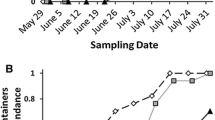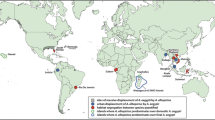Abstract
Invasion success and species coexistence are often mediated by species interactions across patchily distributed habitats and resources. The invasive mosquito Aedes japonicus japonicus has established in the North American range of the competitively superior resident congener, Aedes albopictus, and the predatory native mosquito Toxorhynchites rutilus. We tested predictions for two hypotheses of invasion success and species coexistence: keystone predation and spatial partitioning. We tested competition between A. japonicus japonicus and A. albopictus with or without T. rutilus in laboratory microcosms, and measured abundances of A. japonicus japonicus, A. albopictus, other resident competing mosquito species, and the presence of T. rutilus among tree holes and tires in metropolitan Washington, DC. In laboratory microcosms, A. albopictus was competitively dominant over A. japonicus japonicus, which is consistent with the few prior studies of competition between these two Aedes species. T. rutilus predation severely lowered performances of both Aedes species but more severely lowered A. japonicus japonicus performance than A. albopictus performance when all three species co-occurred, thus yielding no evidence for keystone predation. Consistent with the spatial partitioning hypothesis, A. japonicus japonicus was negatively correlated and independently aggregated with A. albopictus and all combined resident mosquito competitors and was not associated with T. rutilus among field containers. These results suggest that predation from T. rutilus and competition from A. albopictus are barriers to the spread of A. japonicus japonicus, but that A. japonicus japonicus may escape these interspecific effects by utilizing spatially partitioned container habitats.


Similar content being viewed by others
References
Abós CP, Lepori F, McKie BG, Malmqvist B (2006) Aggregation among resource patches can promote coexistence in stream-living shredders. Freshwater Biol 51:545–553
Armistead JS, Arias JR, Nishimura N, Lounibos LP (2008a) Interspecific larval competition between Aedes albopictus and Aedes japonicus (Diptera: Culicidae) in Northern Virginia. J Med Entomol 45:629–637
Armistead JS, Nishimura N, Escher RL, Lounibos LP (2008b) Larval competition between Aedes japonicus and Aedes atropalpus (Diptera: Culicidae) in simulated rock pools. J Vector Ecol 33:238–246
Armistead JS, Nishimura N, Arias JR, Lounibos LP (2012) Community ecology of container mosquitoes (Diptera: Culicidae) in Virginia following invasion by Aedes japonicus. J Med Entomol 49:1318–1327
Bargielowski IE, Lounibos LP, Carrasquilla MC (2013) Evolution of resistance to satyrization through reproductive character displacement in populations of invasive dengue vectors. Proc Natl Acad Sci USA 110:2888–2892
Blaustein L, Chase JM (2007) Interactions between mosquito larvae and species that share the same trophic level. Annu Rev Entomol 52:489–507
Carpenter SR (1983) Resource limitation of larval treehole mosquitos subsisting on beech detritus. Ecology 64:219–223
Case TJ (1991) Invasion resistance, species buildup, and community collapse in metapopulation models with interspecies competition. Biol J Linn Soc 42:239–266
Chesson P (2000) General theory of competitive coexistence in spatially-varying environments. Theor Popul Biol 58:211–237
Dunson WA, Travis J (1991) The role of abiotic factors in community organization. Am Nat 138:1067–1091
Fader JE, Juliano SA (2013) An empirical test of the aggregation model of coexistence and consequences for competing container-dwelling mosquitoes. Ecology 94:478–488
Farajollahi A, Kesavaraju B, Nelder MP, Crans SC, Gaugler R (2009) An unusual larval collection and survival of Orthopodomyia signifera in the presence of the predator Toxorhynchites rutilus septentrionalis. J Am Mosq Contr Assoc 25:370–373
Fonseca DM, Widdel AK, Hutchinson M, Spichiger SE, Kramer LD (2010) Fine-scale spatial and temporal population genetics of Aedes japonicus, a new US mosquito, reveal multiple introductions. Mol Ecol 19:1559–1572
Grill CP, Juliano SA (1996) Predicting species interactions based on behaviour: predation and competition in container-dwelling mosquitoes. J Anim Ecol 65:63–76
Griswold MW, Lounibos LP (2005) Does differential predation permit invasive and native mosquito larvae to coexist in Florida? Ecol Entomol 30:122–127
Griswold MW, Lounibos LP (2006) Predator identity and additive effects in a treehole community. Ecology 87:987–995
Hardin G (1960) Competitive exclusion principal. Science 131:1292–1297
Hardstone MC, Andreadis TG (2012) Weak larval competition between the invasive mosquito Aedes japonicus japonicus (Diptera: Culicidae) and three resident container-inhabiting mosquitoes in the laboratory. J Med Entomol 49:277–285
Hartley S, Shorrocks B (2002) A general framework for the aggregation model of coexistence. J Anim Ecol 71:651–662
Hawley WA, Reiter P, Copeland RS, Pumpuni CB, Craig GB (1987) Aedes albopictus in North America—probable introduction in used tires from Northern Asia. Science 236:1114–1116
Ives AR (1988a) Aggregation and the coexistence of competitors. Ann Zool Fenn 25:75–88
Ives AR (1988b) Covariance, coexistence and the population dynamics of two competitors using a patchy resource. J Theor Biol 133:345–361
Ives AR (1991) Aggregation and coexistence in a carrion fly community. Ecol Monogr 61:75–94
Juliano SA (1998) Species introduction and replacement among mosquitoes: interspecific resource competition or apparent competition? Ecology 79:255–268
Juliano SA (2009) Species interactions among larval mosquitoes: context dependence across habitat gradients. Annu Rev Entomol 54:37–56
Juliano S, Lounibos L (2005) Ecology of invasive mosquitoes: effects on resident species and on human health. Ecol Lett 8:558–574
Kaufman MG, Walker ED (2006) Indirect effects of soluble nitrogen on growth of Ochlerotatus triseriatus larvae in container habitats. J Med Entomol 43:677–688
Kaufman MG, Goodfriend W, Kohler-Garrigan A, Walker ED, Klug MJ (2002) Soluble nutrient effects on microbial communities and mosquito production in Ochlerotatus triseriatus habitats. Aquat Microb Ecol 29:73–88
Kesavaraju B, Khan DF, Gaugler R (2011) Behavioral differences of invasive container-dwelling mosquitoes to a native predator. J Med Entomol 48:526–532
Kilpatrick AM, Kramer LD, Jones MJ, Marra PP, Daszak P (2006) West Nile virus epidemics in North America are driven by shifts in mosquito feeding behavior. PLoS Biol 4:e82
Leisnham PT, Juliano SA (2009) Spatial and temporal patterns of coexistence between competing Aedes mosquitoes in urban Florida. Oecologia 160:343–352
Leisnham PT, Juliano SA (2010) Interpopulation differences in competitive effect and response of the mosquito Aedes aegypti and resistance to invasion by a superior competitor. Oecologia 164:221–230
Leisnham PT, Lounibos LP, O’Meara GF, Juliano SA (2009) Interpopulation divergence in competitive interactions of the mosquito Aedes albopictus. Ecology 90:2405–2413
Leonard PM, Juliano SA (1995) Effect of leaf litter and density on fitness and population performance of the hole mosquito Aedes triseriatus. Ecol Entomol 20:125–136
Lodge DM (1993) Biological invasions—lessons for ecology. Trends Ecol Evol 8:133–137
Lounibos LP, Nishimura N, Escher RL (1993) Fitness of a treehole mosquito—influences of food type and predation. Oikos 66:114–118
Lounibos LP, Escher RL, Nishimura N, Juliano SA (1997) Long-term dynamics of a predator used for biological control and decoupling from mosquito prey in a subtropical treehole ecosystem. Oecologia 111:189–200
MacArthur RH (1972) Geographical ecology. Harper and Row, New York
Macìas-Duarte A, Alvarado-Castro JA, Dórame-Navarro ME, Félix-Torres AA (2009) Dispersal and oviposition of laboratory-reared gravid females of Toxorhynchites moctezuma in an arid urban area of Sonora. J Am Mosq Contr Assoc 25:417–424
Moen J (1989) Diffuse competition—a diffuse concept. Oikos 54:260–263
Mogi M, Sembel DT (1996) Predator-prey system structure in patchy and ephemeral phytotelmata: aquatic communities in small aroid axils. Res Popul Ecol 38:95–103
Moore CG, Francy DB, Eliason DA, Monath TP (1988) Aedes albopictus in the United States: rapid spread of a potential disease vector. J Am Mosq Contr Assoc 4:356–361
Murphy JF, Giller PS, Horan MA (1998) Spatial scale and the aggregation of stream macroinvertebrates associated with leaf packs. Freshwater Biol 39:325–337
Nachman G (2006) A functional response model of a predator population foraging in a patchy habitat. J Anim Ecol 75:948–958
Peyton EL, Campbell SR, Candeletti TM, Romanowski M, Crans WJ (1999) Aedes (Finlaya) japonicus japonicus (Theobald), a new introduction into the United States. J Am Mosq Contr Assoc 15:238–241
Reznick D, Butler MJ, Rodd H (2001) Life-history evolution in guppies. VII. The comparative ecology of high- and low-predation environments. Am Nat 157:126–140
Sardelis MR, Turell MJ (2001) Ochlerotatus j. japonicus in Frederick County, Maryland: discovery, distribution, and vector competence for West Nile virus. J Am Mosq Contr Assoc 17:137–141
Sardelis MR, Dohm DJ, Pagac B, Andre RG, Turell MJ (2002a) Experimental transmission of eastern equine encephalitis virus by Ochlerotatus j. japonicus (Diptera: Culicidae). J Med Entomol 39:480–484
Sardelis MR, Turell MJ, Andre ARG (2002b) Laboratory transmission of La Crosse virus by Ochlerotatus j. japonicus (Diptera: culicidae). J Med Entomol 39:635–639
Sardelis MR, Turell MJ, Andre RG (2003) Experimental transmission of St. Louis encephalitis virus by Ochlerotatus j. japonicus. J Am Mosq Contr Assoc 19:159–162
SAS Institute (2003) SAS user’s guide. Statistics. Version 9.1. SAS Institute, Cary, NC
Scheiner SM (2001) MANOVA: multiple response variables and multispecies interactions. In: Scheiner SM, Gurevitch J (eds) Design and analysis of ecological experiments, 2nd edn. Oxford University Press, Oxford, pp 99–133
Schmera D (2004) Spatial distribution and coexistence patterns of caddisfly larvae (Trichoptera) in a Hungarian stream. Int Rev Hydrobiol 89:51–57
Sevenster JG (1996) Aggregation and coexistence. 1. Theory and analysis. J Anim Ecol 65:297–307
Sevenster JG, VanAlphen JJM (1996) Aggregation and coexistence. 2. A Neotropical Drosophila community. J Anim Ecol 65:308–324
Shea K, Chesson P (2002) Community ecology theory as a framework for biological invasions. Trends Ecol Evol 17:170–176
Shorrocks B, Rosewell J (1986) Guild size in drosophilids: a simulation model. J Anim Ecol 55:527–541
Shorrocks B, Atkinson W, Charlesworth P (1979) Competition on a divided and ephemeral resource. J Anim Ecol 48:899–908
Simberloff D, Boecklen W (1991) Patterns of extinction in the introduced Hawaiian avifauna: a reexamination of the role of competition. Am Nat 138:300–327
Smith C, Baldwin AH, Sullivan J, Leisnham PT (2013) Effects of elevated atmospheric CO2 on competition between the mosquitoes Aedes albopictus and Ae. triseriatus via changes in litter quality and production. J Med Entomol 50:521–532
Sokal RR, Rohlf FJ (1995) Biometry: the principles and practice of statistics in biological research, 3rd edn. Freeman, New York
Steel RG, Torrie JH (1980) Principles and procedures of statistics: a biometrical approach, 2nd edn. McGraw-Hill, New York
Sunahara T, Ishizaka K, Mogi M (2002) Habitat size: a factor determining the opportunity for encounters between mosquito larvae and aquatic predators. J Vector Ecol 27:8–20
Tilman D (1982) Resource competition and community structure. Princeton University Press, Princeton
Trimble RM (1979) Laboratory observations on oviposition by the predaceous tree-hole mosquito, Toxorhynchites rutilus septentrionalis (Diptera: Culicidae). Can J Zool 57:1104–1108
Tripet F, et al. (2011) Competitive reduction by satyrization? Evidence for interspecific mating in nature and asymmetric reproductive competition between invasive mosquito vectors. Am J Trop Med Hyg 85:265–270
Walker ED, Lawson DL, Merritt RW, Morgan WT, Klug MG (1991) Nutrient dynamics, bacterial populations, and mosquito productivity in tree hole ecosystems and microcosms. Ecology 72:1529–1546
Williams DD, Tavarescromar A, Kushner DJ, Coleman JR (1993) Colonization patters and life-history dynamics of Culex mosquitos in artificial ponds of different character. Can J Zool 71:568–578
Wootton JT (2002) Indirect effects in complex ecosystems: recent progress and future challenges. J Sea Res 48:157–172
Yee DA (2008) Tires as habitats for mosquitoes: a review of studies within the eastern United States. J Med Entomol 45:581–593
Yee DA, Juliano SA (2006) Consequences of detritus type in an aquatic microsystem: effects of water quality, micro-organisms and performance of the dominant consumer. J Freshwater Biol 51:448–459
Yoshioka M, Couret J, Kim F, McMillan J, Burkot TR, Dotson EM, Kitron U, Gonzalo MV-P (2012) Diet and density dependent competition affect larval performance and oviposition site selection in the mosquito species Aedes albopictus (Diptera: Culicidae). Parasit Vectors 5:225
Acknowledgments
We thank B. Kesavaraju; L. McCuiston, Center of Vector Biology; S. A. Juliano, Illinois State University; R. Pozzatti, I. Terry, K. Iwata, N. Kirchoff, and D. Bodner, for useful discussion, for providing us with eggs, for experiment maintenance, or for data collection. We thank S. A. Juliano, S. LaDeau, and B. H. Momen for statistical advice, and two anonymous reviewers for excellent comments. This research was funded by a Maryland Agriculture Experimental Station grant MD-ENST-5739 to P. T. L. and the Washington Biologists Field Club grant to P. T. L. and T. Z. F.
Author information
Authors and Affiliations
Corresponding author
Additional information
Communicated by Steven Kohler.
Electronic supplementary material
Below is the link to the electronic supplementary material.
Rights and permissions
About this article
Cite this article
Freed, T.Z., Leisnham, P.T. Roles of spatial partitioning, competition, and predation in the North American invasion of an exotic mosquito. Oecologia 175, 601–611 (2014). https://doi.org/10.1007/s00442-014-2909-7
Received:
Accepted:
Published:
Issue Date:
DOI: https://doi.org/10.1007/s00442-014-2909-7




